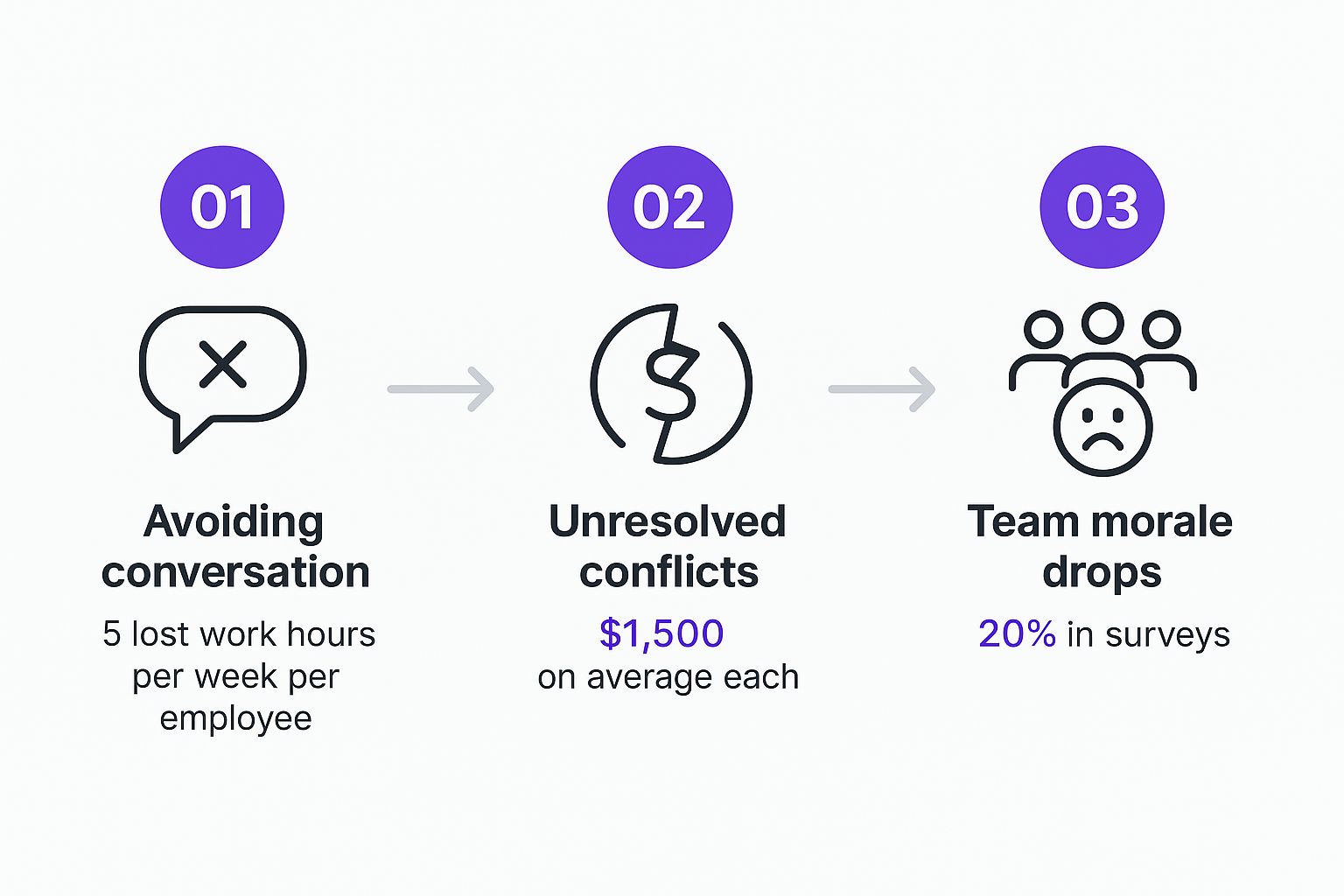How to Handle Difficult Conversations with Confidence
Let's be real—nobody looks forward to having a difficult conversation. That knot in your stomach? We've all been there. But dodging those tough talks doesn't make the problem go away. It just creates bigger, messier issues that quietly poison your team's culture.
It's completely human to want to avoid discomfort. The thing is, the fallout from staying silent is almost always worse than the temporary awkwardness of speaking up.
This isn't just about hurt feelings; it's about the bottom line. Unresolved issues fester. They breed misunderstandings, erode trust, and create a toxic environment where good ideas and teamwork go to die.
The Hidden Financial Drain of Conflict
The cost of avoidance is written all over your balance sheet. One recent analysis found that workplace conflict drains U.S. businesses of about $359 billion every single year.
Think about it: employees spend an average of 2.8 hours a week dealing with disputes. And managers? They burn a shocking 20–40% of their time trying to put out these fires. That’s precious time that could be spent on actual, productive work.
The human cost is just as high. Employees stuck in a high-conflict workplace are twice as likely to start looking for another job. That turnover means more recruiting costs, lost knowledge, and a team morale that's in the gutter. The stress can feel a lot like the pressure of a tough job search, which is why learning how to handle rejection and conflict are such vital career skills. You can learn more about dealing with job rejection and see how the skills overlap.
The problem isn't the conflict. It's the lack of skill in navigating it. Being able to handle these conversations isn't just a "soft skill"—it's a core leadership competency.
This infographic breaks down how quickly one avoided conversation snowballs, turning into lost hours, drained finances, and tanking morale.

As you can see, what starts as a simple talk you put off for another day quickly spirals. It costs you time, money, and your team's engagement. By facing these issues head-on, you turn a potential disaster into a chance to build a stronger, more resilient team.
Your Strategic Framework for a Successful Dialogue

Here’s a hard truth: the outcome of a high-stakes conversation is often decided before anyone even opens their mouth. Going in cold is a recipe for disaster.
But when you have a plan, you shift the entire dynamic. It stops being a confrontation and starts becoming a collaborative problem-solving session. This isn’t about scripting your every word, but about setting the stage for a productive, respectful talk where a real resolution is actually possible.
First, Nail Down Your One Clear Objective
Before you send that calendar invite, stop and ask yourself: What is the one thing I absolutely need to achieve with this conversation?
If your goal is fuzzy—like "clearing the air" or "fixing the tension"—you're setting yourself up for a long, winding talk that goes nowhere. Your objective needs to be specific and forward-looking.
Instead of aiming to "make them see they were wrong," a much stronger goal is "to agree on a new handoff process so we can stop missing deadlines." This single, clear objective becomes your North Star. When things get heated or the conversation starts to drift, you can always bring it back to that core purpose.
Gather Facts, Not Feelings
Your feelings are valid, but they aren't evidence. To keep a difficult conversation on track, you need to anchor it in objective, undeniable facts.
Take some time beforehand to gather specific, non-debatable examples that illustrate the problem.
- Weak: "You're always late with your reports." (This just invites an argument.)
- Strong: "For the last three weeks, the weekly report has been submitted after the Friday 5 PM deadline—on Monday morning, Tuesday afternoon, and the previous Monday."
This fact-based approach immediately shifts the focus from a personal attack to a shared look at a tangible problem. It's much harder to argue with data.
When you present facts, you invite the other person to analyze a situation with you. When you lead with feelings and accusations, you invite them to defend themselves. The difference is everything.
Map Out the Conversation's Potential Paths
Tough conversations are unpredictable, but you can anticipate the most likely twists and turns. Think of it as a "choose your own adventure" game. A few minutes of planning can save you from being completely blindsided.
What are the most likely ways this could go?
- What if they get defensive? Your move isn't to get defensive back. It's to calmly restate the facts and remind them of your shared objective.
- What if they just shut down? You might suggest taking a five-minute break, or you could ask a gentle, open-ended question like, "I can see this is tough to talk about. Can you share what's on your mind?"
- What if they agree there's a problem? Perfect. Be ready to pivot straight into brainstorming solutions together.
This mental rehearsal builds confidence. You won't have a perfect script, but you'll have a game plan for the most common roadblocks.
To help you get organized, here’s a simple checklist you can run through before any important discussion.
The PREP Framework for Difficult Conversations
This simple framework ensures you’ve covered all your bases before walking into the room.
| Phase | Key Action | Example Question to Ask Yourself |
|---|---|---|
| Purpose | Define your single, non-negotiable outcome. | What is the one thing that must be decided or agreed upon by the end of this talk? |
| Research | Gather specific, objective data and examples. | Do I have at least three concrete, fact-based examples to share? |
| Emotional State | Check in with yourself and get centered. | Am I walking into this conversation feeling calm and constructive, or am I angry and anxious? |
| Planning | Anticipate potential reactions and plan responses. | What are the three most likely ways the other person might react, and how will I respond to each? |
Running through these steps will leave you feeling far more prepared and in control of the situation.
Finally, Manage Your Own State of Mind
This is the one piece of the puzzle that's 100% within your control. You can’t dictate how someone else will react, but you are in complete charge of your own emotional state.
Walking into a tough talk feeling angry, anxious, or resentful is a surefire way to get a bad result. Before the meeting, do whatever you need to do to get centered. Take a quick walk, do some deep breathing exercises, or vent to a trusted friend for five minutes.
Your goal is to walk in calm, collected, and focused. Interestingly, the need for a clear plan isn't unique to HR; lessons from marketing on strategic planning for effective dialogue also highlight how crucial clear objectives and preparation are.
Mastering this preparation is a huge part of your own career growth. For a deeper look at building these kinds of skills, our guide on professional development planning can help. By preparing your strategy and your mindset, you turn a dreaded conversation into a genuine opportunity for progress.
Practical Communication Techniques for High-Stakes Talks

This is where the rubber meets the road. You've done your prep work, and now you’re in the room, face-to-face. The techniques you use in these next few moments will decide whether you have a productive dialogue or a complete meltdown.
The trick is to stop thinking of it as an argument to be won. It's not "you vs. me." Frame it as "us vs. the problem." When you mentally put yourself on the same side of the table, you shift the entire dynamic from confrontation to collaboration. That single change is the foundation of every successful tough conversation I've ever had or witnessed.
Opening the Dialogue on a Neutral Footing
How you kick things off sets the tone for everything. If you lead with an accusation, you’ve already lost. The other person’s walls will go up, and any chance for a real discussion vanishes.
Your first words should be a bridge, not a battering ram. Start with a neutral, collaborative statement that makes your positive intentions clear. Show them you’re here to solve a problem together, not to point fingers.
Here are a few ways I’ve seen this work well:
- For a process problem: "I’d love to talk about the last project so we can figure out a smoother workflow for the next one. My goal is to make sure we're both set up for success."
- For giving tough feedback: "I really value your work on the team. I wanted to chat about the client presentation to make sure we're totally aligned on our communication style."
- For a team conflict: "I’ve felt some tension between us lately, and I want to clear the air. It’s important to me that we can get back to working well together."
These kinds of openers are disarming. They lead with a shared goal and create a safe space for the other person to engage honestly.
Exploring the Issue With Genuine Curiosity
Once the conversation has started, your next job is to listen. Really listen. This is where most people trip up—they're not listening to understand; they're just waiting for their turn to talk.
To avoid that trap, you need to ask great questions and then actually hear the answers. Forget simple yes/no questions. You need open-ended prompts that get them talking.
Try questions like these:
- "Can you walk me through your thinking on that?"
- "From your perspective, what’s causing this to happen?"
- "What’s getting in your way?"
- "How did you experience that situation?"
As they answer, give them your full attention. Don't interrupt or mentally prepare your rebuttal. Just focus on what they're saying with their words and their body language.
Active listening isn’t just being quiet. It’s a genuine effort to crawl inside someone else's point of view and understand their experience. It’s the single greatest sign of respect you can offer.
After they’ve shared, reflect back what you heard. Something as simple as, "So, if I’m hearing you right, you felt blindsided because you didn't get the data until the last minute. Is that about right?" does two things: It confirms you understood, and it validates their feelings. Defenses will drop.
Sharing Your Perspective Without Placing Blame
Okay, you’ve listened. Now it's your turn. The goal here is to share your experience without making it sound like an accusation. The best tool for the job? The "I statement."
An "I statement" isn't about their intentions or their character flaws. It’s about the tangible impact their behavior had on you.
The formula is simple but incredibly effective:
- I feel [your emotion]
- when [the specific, observable behavior]
- because [the impact on you].
Let's say a colleague keeps missing deadlines, which messes up your work.
- A Blaming Statement: "You're so unreliable. Because you're always late, I'm now behind on my own work."
- An "I Statement": "I feel stressed when the reports are submitted after the deadline because it forces me to rush my part of the project."
See the difference? The first one is a personal attack that just begs for a defensive argument. The second is an undeniable statement about your reality. It's much harder to argue with how you feel.
Moving Toward a Collaborative Solution
The final stretch is about building the solution—together. You're not here to lay down the law. You're here to brainstorm options that work for everyone involved.
Kick it off with a collaborative question. "Given everything we've talked about, what are some ideas for how we could approach this differently next time?" This simple question invites them into the problem-solving process, which is critical for getting their buy-in.
Listen to their ideas with an open mind. Build on them. Offer your own. Your goal is to find a path forward that addresses the core needs you've both shared.
Mastering these skills is no longer a "nice-to-have." Research shows that workplace conflict has actually doubled since 2008, and 36% of employees now deal with it frequently. Poor communication is almost always the culprit. And according to the research on rising workplace conflict, when managers botch these talks, team morale and inclusion take a nosedive.
Ultimately, handling a difficult conversation is a skill. It takes practice. If you're looking to build your confidence, many of the same principles apply in other high-stakes situations. Check out our guide on how to improve your job interview practice to sharpen your communication skills for your next career move.
Navigating Roadblocks and Common Pitfalls

You’ve done all the prep work, you’ve started the conversation on the right foot, and then… it happens. You feel the energy in the room shift. Their arms are crossed, their tone is sharp, and the productive dialogue you envisioned is starting to feel more like a standoff. We’ve all been there.
The real skill in how to handle difficult conversations isn't just in the setup; it's in your ability to adapt when things go sideways. The trick is to spot the derailment as it’s happening and have a few moves ready to pull the conversation back from the brink.
Think of these roadblocks as signals, not failures. A big emotional reaction is just data. It’s telling you that you’ve hit on something that really, truly matters to the other person. Your job now is to get curious, not defensive.
When Emotions Run High
One of the most common ways a conversation gets derailed is an emotional hijacking. When anger, frustration, or defensiveness take the wheel, logic gets kicked to the curb. Trying to push your agenda at this point is like arguing with a hurricane. It’s a waste of energy, and you’re just going to get drenched.
The smartest thing you can do is hit the pause button. This isn’t about giving up; it’s about managing the emotional temperature so you can actually get back to a productive place.
A simple phrase can work miracles here:
- "I can see this is hitting a nerve. How about we take five minutes to regroup?"
- "It sounds like you're really frustrated. I want to make sure I understand why."
This validates how they're feeling without you having to agree with their point. You're showing them respect, and often, that’s enough to bring the tension down a few notches so you can start talking again.
Handling Defensiveness and Shutdowns
So, what happens when the other person just shuts down? Or worse, gets incredibly defensive? This is usually a neon sign flashing "I feel attacked." If you push harder, they're only going to retreat further or build their walls even higher.
Don't just repeat your point louder. Instead, change the frame. Bring the focus back to a goal you both actually care about.
Let's say you're talking to a team member about being consistently late. They shoot back with, "I'm doing my best! It feels like nothing is ever good enough for you."
Instead of getting into a fight, pivot to your shared goal:
- Try this: "My intention isn't to criticize. My goal is to make sure the team can hit our morning deadlines without that last-minute scramble, which I know stresses everyone out. How can we work together to make the mornings run smoother for you and the team?"
See the difference? You’ve reframed the issue from "you are the problem" to "let's solve this problem together." It completely shifts the dynamic. For more ideas on navigating these tricky spots, it’s worth looking into strategies for tackling workplace issues with grace, which often hinge on this kind of careful reframing.
Key Takeaway: When you hit a wall, don't try to knock it down. Instead, find a shared door you can both walk through. A common goal is that door.
Avoiding Your Own Common Traps
It's easy to point fingers at the other person, but sometimes we are the ones steering the conversation into a ditch without even knowing it. Two of the biggest culprits are using loaded language and making assumptions.
Loaded language is any word that comes with heavy emotional baggage. Think "always," "never," "lazy," or "irresponsible." They're conversation killers that immediately put people on the defensive.
Making assumptions is just as bad. When you assume you know someone's motives ("You clearly did that on purpose to undermine me!"), you slam the door on any chance of understanding their real perspective.
Before you speak, do a quick mental check:
- Am I stating a fact or is this my judgment?
- Am I asking about their intention or am I assigning one to them?
By keeping an eye on your own language, you maintain a level of respect that makes it much easier for the other person to stay engaged. The goal is to talk about observable behaviors and their impact, not to get into character assassinations that go absolutely nowhere.
Forging Actionable and Lasting Resolutions
Let's be honest: the conversation isn't really over just because everyone walked out of the room. A difficult talk only succeeds when you have a real, sustainable solution locked in.
Getting to a point of mutual understanding is a huge milestone, but without a clear path forward, you’re just setting yourself up to have the same painful conversation again in a few weeks. The final, most crucial phase is turning that hard-won agreement into concrete action.
This is where you pivot from rehashing the past to actually building a better future together. The goal is no longer just about being heard; it’s about co-creating a new way of working. You're not just handing down a verdict—you're designing a solution as a team. This is the only way to get genuine buy-in.
From Agreement to Action Plan
A vague promise to "do better" is a recipe for failure. To make any progress stick, you have to translate good intentions into specific, measurable steps. Think of it as moving from a handshake deal to a blueprint that leaves no room for confusion.
The most effective way I’ve found to do this is by defining the "who, what, and when" for every single part of the solution. This simple framework cuts through the ambiguity and builds accountability from the get-go.
Here's how it plays out:
- Who is responsible? Put a name next to each task. This completely eliminates any "I thought you were doing that" confusion down the line.
- What will they do? Get ridiculously specific. Don't settle for "improve communication." Instead, try "send a weekly progress summary email every Friday by 4 PM."
- When will it be done? Slap a realistic deadline on it. A clear timeline creates a healthy sense of urgency and gives you a benchmark for success.
Suddenly, a well-meaning chat transforms into a tangible project plan. Everyone leaves knowing exactly what's expected of them, and that’s the bedrock of any lasting resolution.
Documenting and Following Up
Even with the best intentions, memories get fuzzy and details get lost. That's why documenting what you agreed upon is absolutely non-negotiable.
This doesn't have to be some formal, intimidating contract. A simple follow-up email is usually all it takes.
Just recap the main issue, outline the specific action items (using that "who, what, when" format), and set a date for a quick check-in. This email becomes your shared source of truth, keeping everyone aligned and accountable.
A follow-up isn't about micromanagement; it's about mutual respect. It signals that you took the conversation seriously and are committed to supporting the agreed-upon changes.
Get a brief check-in on the calendar for a week or two out. This reinforces that you're all in this together and creates a space to see what’s working, what isn’t, and if you need to tweak the plan.
Why This Final Step Matters
Closing the loop is where so many well-intentioned leaders stumble. In fact, recent research found that a startling 49% of manager candidates can't demonstrate effective conflict management skills.
The data reveals some clear gaps: 61% struggle to even clarify the core issue, and 65% have a hard time offering the support needed to actually resolve it. The good news? Professionals are overwhelmingly open to compromise. You can discover more about managing conflict research from DDI to see the full picture.
This really highlights that building a clear, actionable plan is what separates a conversation that feels good from one that actually creates change. By focusing on a shared path forward, you ensure your toughest conversations lead to real progress and a stronger, more resilient team.
Common Questions About Difficult Conversations
Even the best-laid plans can go sideways. Knowing how to handle difficult conversations really comes down to being able to think on your feet.
Let's walk through a few of the most common curveballs I see people face and how to handle them. Every tough conversation is a chance to get better at this, so long as you remember to stay focused on respect, clarity, and finding a way forward together.
What If the Conversation Is with My Boss?
This one is tricky. When you have to broach a tough subject with your boss, the power dynamic definitely shifts the feel of the room. But the fundamentals still hold true.
The absolute key here is preparation. You need to frame the entire conversation around shared goals—things like the project's success, the team's output, or hitting a department metric. This isn't the time for personal complaints.
Come armed with specific, objective examples. Data is your best friend. And instead of marching in with demands, position yourself as a collaborative problem-solver.
A great way to phrase it is, "I've run into a challenge with X, and I'd love to get your take on how we could tackle it. I think it could really help the team." It shows respect for their position while letting you bring a serious issue to the table.
How Do I Handle a Difficult Conversation Over a Video Call?
Ah, the virtual minefield. Remote conversations mean you have to be so much more deliberate. You can't rely on the natural rapport that comes from being in the same room, so you have to create it.
Here’s my checklist for any tough talk over Zoom or Teams:
- Video on. Period. You need to see each other. Non-verbal cues, even on a screen, are better than nothing.
- Over-communicate. Be painfully explicit. Summarize what you’ve heard and ask things like, "Does that sound right to you?" far more often than you would in person.
- Embrace the pause. Silence isn't always awkward. Give the other person a beat to think and respond without feeling rushed.
- Ditch the distractions. Close your other tabs. Put your phone on silent and flip it over. Give them your full, undivided attention. It shows respect.
How Do I Give Negative Feedback Without Crushing Morale?
This is a big one. Feedback should always, always be about making things better in the future, not punishing someone for the past. To do that, you have to separate the person from the behavior.
I'm a big fan of the "Situation-Behavior-Impact" (SBI) model. It’s a simple, direct framework that keeps things objective.
- Situation: Start with the specific when and where. "In yesterday's client meeting…"
- Behavior: Describe what you observed—no judgment, just facts. "…when you cut the client off a few times while they were speaking…"
- Impact: Explain the consequence. "…I was worried we might have come across as impatient."
The crucial next step is to immediately pivot to a positive, forward-looking solution. Something like, "For the next call, let's brainstorm a few ways to make sure the client feels fully heard." This turns a critique into a coaching moment.
Learning to frame your thoughts this way is a skill. Practicing with tools like an interview answer generator can actually help you get better at articulating feedback clearly and constructively.
Mastering these conversations is a huge part of moving your career forward. While you're busy honing these essential skills, let Eztrackr handle the logistics of your job hunt. You can manage all your applications, generate documents, and track everything in one simple dashboard at https://eztrackr.app.
 Interview Sidekick
Interview Sidekick